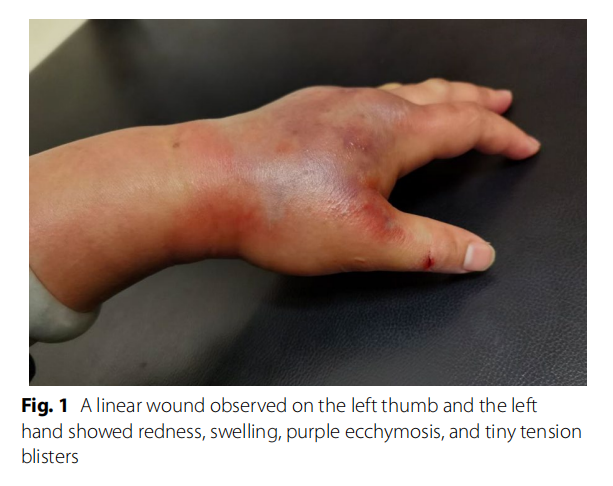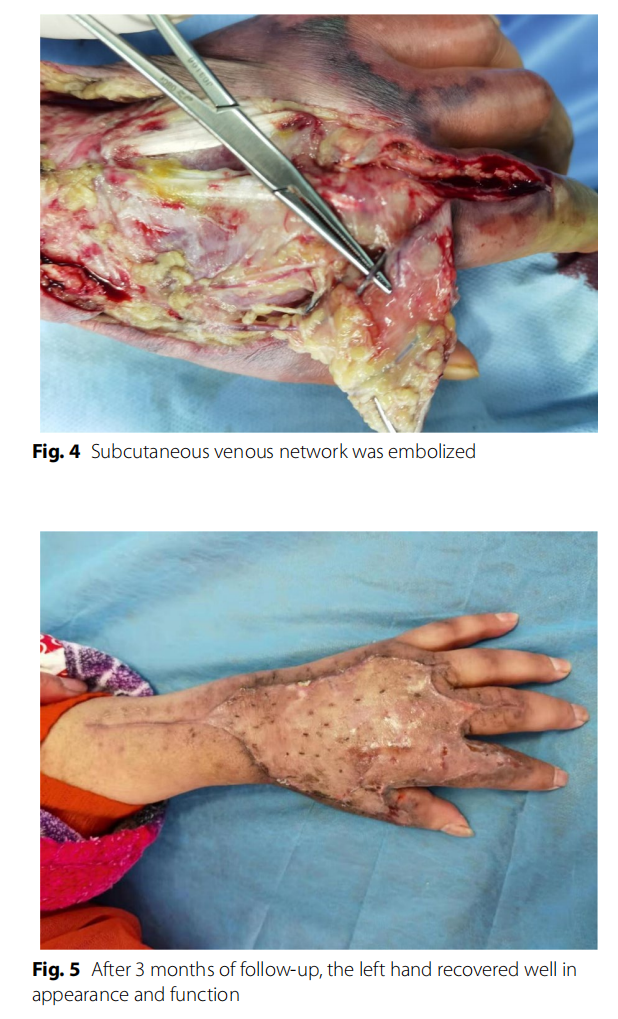Introduction
Aeromonas is a genus of Gram-negative bacilli widely distributed in aquatic environments and can infect the human body through the fecal–oral route or wounds to cause diseases, mainly manifesting as gastroenteritis, wound infections, and septicemia [1]. We report a case of severe infection by Aeromonas veronii in the left upper limb caused by accidental injury to the left thumb while cutting a fish.
Case presentation
A 50-year-old Chinese woman accidentally injured her left thumb at 5 pm, while cutting a fish for dinner. She washed the wound with cold, running water for 1 minute and applied a bandage. However, on the night of the incident, her left thumb became red and swollen, which gradually spread to the left dorsal hand and extended to the forearm within 12 hours after the injury, warranting a visit to the emergency department of local hospital the next morning. The doctor recommended hospitalization for surgery. She refused and came to our hospital for treatment a day after the injury.
During admission, there was significant swelling on the dorsum of the left hand and left forearm, high tension, and severe infection. She had a history of dilated cardiomyopathy, chronic heart failure, atrial fibrillation, and type 2 diabetes. Physical examination on admission showed a temperature of 36.8 °C, pulse rate of 80 beats per minute, respiratory rate of 20 breaths per minute, and blood pressure of 87/54 mmHg. A linear wound was also observed at approximately 0.5 cm in length at the left thumb interphalangeal joint on the radial side. The skin and soft tissues of the left hand and the left forearm were red and swollen, especially the left dorsal hand extending to the left dorsal forearm. A purple ecchymosis was noted on the skin of the left dorsal hand, accompanied by scattered tiny tension blisters, high skin tension, significant tenderness, slightly above normal skin temperature, and a weak pulse in the ulnar and radial arteries (Fig. 1). Emergency laboratory and clinical examinations performed revealed white blood cell count (WBC) of 21.41× 109 /L, N of 92.0%, platelet count (PCT) of 6.72 ng/mL, GLU of 16.4 mmol/L, HbA1c of 8.0%, and BNP>5002 pg/mL. A standard 12-lead electrocardiogram (ECG) showed atrial fibrillation, while a plain computerized tomography (CT) scan of the left forearm and left hand revealed moderate to severe swollen skin and soft tissue.

Initial diagnosis was skin and soft tissue infection in the left upper limb, dilated cardiomyopathy, congestive heart failure (CHF) (grade III cardiac function), atrial fibrillation, postoperative state of cardiac pacemaker implantation, and type 2 diabetes mellitus (DM). Combining the patient’s history of injury, the possibility of infection by aquatic-related bacteria such as Vibrio, Aeromonas, Mycobacterium marinum was considered [2].
Emergency open decompression was performed on the left upper limb. A longitudinal incision was made to the deep fascial layer, along the most significantly swollen site, to achieve complete tension reduction and drainage (Fig. 2). Intraoperatively, a large amount of clear yellow discharge was found in the deep fascia of the dorsal area of the left wrist and hand. We sent the discharge for bacterial culture. The wound was thoroughly flushed with a large amount of hydrogen peroxide, normal saline, and iodophor and then packed and bandaged with iodoform gauze. Postoperatively, we administered antibiotics such as cefoperazone–sulbactam sodium 3 g intravenously twice a day, combined with moxifloxacin 0.4 g once a day. During postoperative change of dressing, we found that the wound infection continued to spread, partly to the second phalanxes, accompanied by skin blackening and tissue necrosis (Fig. 3). On the second day after admission, surgical debridement was performed on the left upper limb. Further open decompression and drainage was conducted. During the operation, the viability of fat and tendon tissues was found to be poor and the subcutaneous venous network was scattered and embolized (Fig. 4); therefore, another discharge sample was sent for bacterial culture. The wound was flushed with a large amount of hydrogen peroxide, normal saline, and iodine and then packed and bandaged with iodoform gauze. On the fourth day after admission, the results of bacterial culture were reported as A. veronii and A. ichthiosmia. The drug sensitivity test results showed that the two bacteria were sensitive to cephalosporins, aminoglycosides, and quinolones but resistant to penicillin and carbapenems. Based on the drug sensitivity test results of the bacterial culture, we administered cefoperazone– sulbactam sodium 3 g intravenously twice daily (BID), combined with levofloxacin 0.5 g four times daily (QD). Subsequently, multiple operations to control the wound infection, and further skin grafting to close the wound, were performed. Finally, the patient recovered and was discharged 1 month after the injury. After 3 months of rehabilitation, the left hand recovered well in appearance and function (Fig. 5). The patient was very satisfied with our treatment and expressed great gratitude.



Discussion
To further confirm whether the infection was caused by the pathogenic bacteria carried by the fish, we tried to track the original fish, but it was no longer available. We then caught the same species of fish from the same river for bacterial culture. We found that the main parasitic bacteria on the fish surface was A. veronii, which was consistent with the bacterial culture results of the patient. Therefore, it was preliminarily determined that the infectious bacteria in this patient came from the fish. However, the drug sensitivity test results showed that veronii was sensitive to all drugs, including penicillin and carbapenem antibiotics, which was inconsistent with the drug sensitivity test results of the cultured bacteria from the wound of our patient. We then conducted whole-genome sequencing of the cultured A. veronii and ichthiosmia from the wound surface, and cultured veronii from the fish skin surface to clarify the difference in drug resistance between these two bacteria. The results showed that both cultured bacteria from the wound surface were A. veronii. A. veronii and A. ichthiosmia are highly homologous in gene sequences, so it is sometimes difficult to distinguish them by general bacterial culture, or by using 16S rRNA [3]. And there are 27 drug-resistant genes in the A. veronii, including the CphA and OXA genes (those that produce metallo-β-lactamase and penicillinase, which can produce drug resistance by hydrolyzing carbapenem and penicillin antibiotics) [4, 5]. However, no drug-resistant genes were found from the cultured A. veronii from the fish skin surface. In recent years, with the wide application of antibiotics in clinical practice and aquaculture, several studies have reported that Aeromonas has evolved and mutated to contain drug-resistant genes, and that A. veronii showed high drug resistance to penicillin (except piperacillin) and carbapenem antibiotics [6, 7]. Sanchez-Cespedes et al . reported a case of cholangitis caused by veronii , in which the drug sensitivity test results showed resistance to imipenem, considered to be caused by the patient’s long-term use of penicillin antibiotics. Tis induced carbapenem resistance of the veronii in the human bile duct [8]. In our case, the patient was not on antibiotics before admission and when the first bacterial culture was taken, with the time from the injury to the first bacterial culture was <36 h; therefore, we did not consider drug resistance caused by a bacterial gene mutation in the human body. Further investigation revealed that sulfonamides and macrolides had been used in the aquaculture lake for a long time, which is the possible reason for veronii’s resistance to penicillin and carbapenem antibiotics.
To date, several studies have reported on human infections caused by A. veronii, mainly in patients with immune disorders such as acute and chronic lymphoblastic leukemia, acute myeloid leukemia, acquired immunodeficiency syndrome, and DM. This often results in severe septicemia and mortality [9]. Our patient had a history of underlying diseases, such as DM and chronic heart disease, which might be an important factor causing the susceptibility and serious illness after infection. In addition, the whole-genome sequencing showed that the cultured A. veronii from the fish skin contained only the virulence genes act, aerA, hlyA, and fa, whereas that from the wound surface contained the virulence genes laf, lip, ascV, aexT, and ascF-ascG in addition to the aforementioned virulence genes. These genes promote bacterial invasion and release of virulence factors, and induce a nonspecific inflammatory response in the human body. Tis may be the reason A. veronii has strong virulence and pathogenicity, which leads to the rapid progress of patients’ illnesses [10, 11].
The spectrum of Aeromonas infections mainly includes gastroenteritis, wound infections, and septicemia. A. veronii has also been reported to generate disorders in several other organs, such as hepatobiliary organs, lungs, kidneys, and bones [12–15]. With regards to antibiotic management, Aeromonas is susceptible to monobactams, carbapenems, third- and fourth-generation cephalosporins, aminoglycosides, and fuoroquinolones [16]. Given that there is an increase in resistance to beta-lactam antibiotics owing to the presence of genes, and that A. veronii is commonly beta-lactamase producing, treatment with broad-spectrum beta-lactams is not recommended [17]. So third- and fourth-generation cephalosporins and fluoroquinolones should be considered first for the treatment of infections caused by A. veronii [18]. Gram stain, culture results, and gene sequencing of the exudate may provide information to guide antibiotic therapy.
In summary, the patient with cardiac disease and type 2 diabetes succeeded in defeating A. veronii with the help of decisive surgery and proper drugs. Gene sequencing, to some extent, can compensate for the shortcomings of bacterial culture, and assist in the diagnosis and treatment of severe skin and soft tissue infection on a genetic level.
Conclusions
We should be alert to possible Aeromonas infection in patients suspected of having skin and soft tissue infection or septicemia caused by aquatic-related bacteria. Moreover, early diagnosis, surgical intervention, and administration of appropriate antibiotics are crucial for patients’ good prognosis.
Acknowledgements
Not applicable.
Author contributions
All of the authors were involved in the clinical care of the patient, preparing and reviewing the manuscript. All authors read and approved the fnal
Funding
This work was supported by the National Natural Science Foundation of China (grant no. 81973816).
Availability of data and materials
All list authors agreed data sharing to this article.
Declarations
Ethics approval and consent to participate
The First Affiliated Hospital of Naval Medical University Ethics Committee guidelines for Case Reports states that ethical review is not required if the patient has provided written consent.
Consent for publication
Written informed consent was obtained from the patient for the publication of this case report and any accompanying images. A copy of the written consent is available for review by the Editor-in-Chief of this journal.
Competing interests
The authors declare that they have no competing interests.
Received: 2 August 2022 Accepted: 9 January 2023
Published online : 30 January 2023
References
1. Janda JM, Abbott SL. The genus Aeromonas: taxonomy, pathogenicity,
2. and infection. Clin Microbiol Rev. 2010;23(1):35–73. Finkelstein R, Oren I. Soft tissue infections caused by marine bacterial pathogens: epidemiology, diagnosis, and management. Curr Infect Dis Rep. 2011;13(5):470–7.
3. Collins MD, Martinez-Murcia AJ, Cai J. Aeromonas enteropelogenes and Aeromonas ichthiosmia are identical to Aeromonas trota and Aeromonas veronii, respectively, as revealed by small-subunit rRNA sequence analysis. Int J Syst Bacteriol. 1993;43(4):855.
4. Walsh TR, Payne DJ, MacGowan AP, et al. A clinical isolate of Aeromonas sobria with three chromosomally mediated inducible β-lactamases: a cephalosporinase, a penicillinase and a third enzyme, displaying carbapenemase activity. J Antimicrob Chemother. 1995;35(2):271–9.
5. Walsh TR, Gamblin S, Emery DC, et al. Enzyme kinetics and biochemical analysis of ImiS, the metallo-β-lactamase from Aeromonas sobria 163a. J Antimicrob Chemother. 1996;37(3):423–31.
6. Overman TL, Janda JM. Antimicrobial susceptibility patterns of Aeromonas jandaei, A. schubertii, A. trota, and A. veronii biotype veronii. J Clin
7. Microbiol. 1999;37(3):706. Lamy B, Kodjo A, Laurent F. Prospective nationwide study of Aeromonas infections in France. J Clin Microbiol. 2009;47(4):1234–7.
8. Sanchez-Cespedes J, Figueras MJ, Aspiroz C, et al. Development of imipenem resistance in an Aeromonas veronii biovar sobria clinical isolate recovered from a patient with cholangitis. J Med Microbiol. 2009;58(4):451–5.
9. Spadaro S, Berselli A, Marangoni E, et al. Aeromonas sobria necrotizing fasciitis and sepsis in an immunocompromised patient: a case report and review of the literature. J Med Case Rep. 2014;8(1):315.
10. Beaz-Hidalgo R, Figueras MJ. Aeromonas spp. whole genomes and viru-lence factors implicated in fish disease. J Fish Dis. 2013;36(4):371–88.
11. Zhou Y, Yu L, Nan Z, et al. Taxonomy, virulence genes and antimicrobial resistance of Aeromonas isolated from extra-intestinal and intestinal infections. BMC Infect Dis. 2019;19(1):158.
12. Jie TTZ, Shelat VG. Aeromonas caviae and Aeromonas veronii causing acute cholecystitis. Surg Infect. 2021;22(8):873–4.
13. Ku YH, Yu WL. Extensive community-acquired pneumonia with hemophagocytic syndrome caused by Aeromonas veronii in an immunocompetent patient. J Microbiol Immunol Infect. 2017;50(4):555–6.
14. Chao CM, Gau SJ, Lai CC. Aeromonas genitourinary tract infection. J Infect. 2012;65(6):573–5.
15. Wang D, Sun F, Li Z, et al. Acute septic arthritis of shoulder joint caused by Aeromonas veronii biotype sobria. Orthopade. 2018;47(12):1027–31.
16. Codjoe FS, Donkor ES. Carbapenem resistance: a review. Med Sci. 2017;6(1):1.
17. Chen PL, Ko WC, Wu CJ. Complexity of β-lactamases among clinical Aeromonas isolates and its clinical implications. J Microbiol Immunol Infect. 2012;45(6):398–403.
18. Fernández-Bravo A, Figueras MJ. An update on the genus Aeromonas: taxonomy, epidemiology, and pathogenicity. Microorganisms. 2020;8(1):129.
Publisher’s Note
Springer Nature remains neutral with regard to jurisdictional claims in published maps and institutional affiliations.
This article is excerpted from the Li et al. Journal of Medical Case Reports (2023) 17:29 by Wound World.


